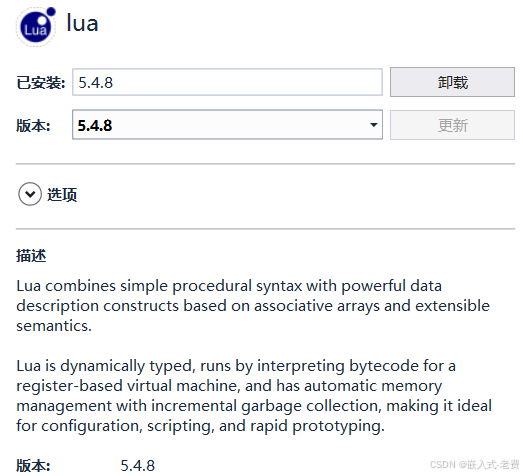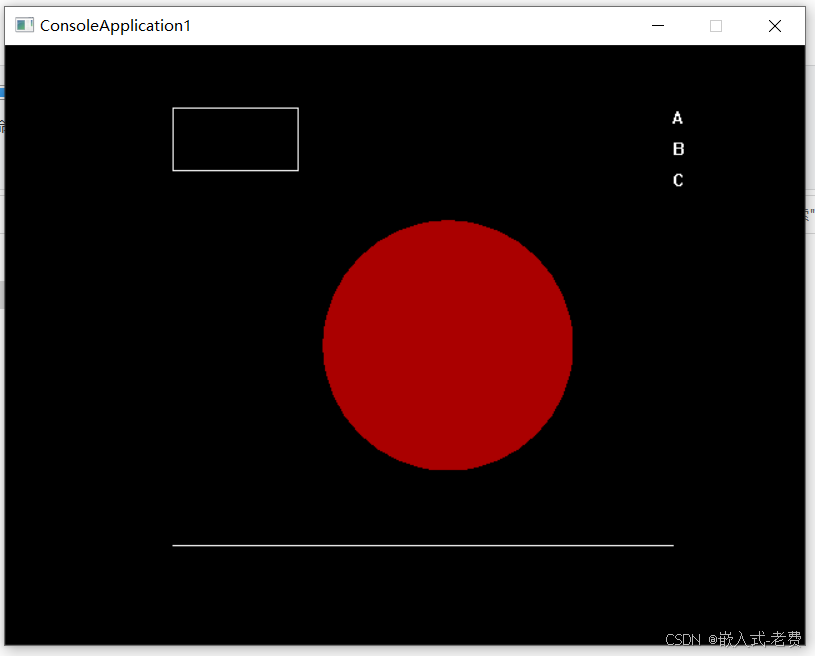【 声明:版权所有,欢迎转载,请勿用于商业用途。 联系信箱:feixiaoxing @163.com】
lua本身是一门胶水语言。很多项目,在底层逻辑部分,都是用c/c++开发。但是业务代码部分,还是采用lua这种脚本语言来完成。这里面很大一部分原因,就是底层框架偏向于基础和原理、性能,而上层脚本偏向于应用。底层的部分改动不多,甚至来说没什么改动。但是业务不一样,可能这个项目是这么来写,那个项目是那么来处理。所以,就需要看怎么把底层结构和上层区分开来。不过今天我们说的lua和easyx,它是比较简单的。主要就是api级别的适配。
1、nuget安装
本身lua是可以自己安装第三方代码,编译生成静态库、动态库的。不过vs2017本身有nuget工具,可以通过它直接下载lua库。里面包含了头文件、静态库、动态库。

2、设置include目录
下载后的lua不能直接使用,需要手动设置下include目录,这一点稍微注意下。
3、api适配
这里的适配,主要是分成四种。一种是没有参数的api适配,这种是最简单的,
static void cleardevice_function(lua_State* L)
{
::cleardevice();
}第二种是有输入参数,但是没有返回值的适配,
static void initgraph_function(lua_State *L)
{
int width = (int)luaL_checkinteger(L, 1);
int height = (int)luaL_checkinteger(L, 2);
::initgraph(width, height);
}第三种,就是有返回值的适配,输入参数可以有,也可以没有。返回值1代表一个返回结果的意思。
static int kbhit_function(lua_State* L)
{
lua_pushinteger(L, _kbhit());
return 1; // 1 means 1 parameter
}最后一种,就是需要创建对象的适配,这种适配一般需要返回一个指针,在实际场景中用的非常多。
static int getimage_function(lua_State* L)
{
int x = (int)luaL_checkinteger(L, 1);
int y = (int)luaL_checkinteger(L, 2);
int width = (int)luaL_checkinteger(L, 3);
int height = (int)luaL_checkinteger(L, 4);
IMAGE* p_image = new IMAGE;
::getimage(p_image, x, y, width, height);
lua_pushinteger(L, (lua_Integer)(p_image));
return 1; // 1 means 1 parameter
}4、适配之后的lua开发
有了api的适配,那么就可以用lua进行程序开发。一般就是exe+lua开发即可。exe是可执行文件,开发之后就不用管了。而lua是程序文件,可以拿过来开发各种业务,比如下面这个简单的lua流程,
-- file: demo.lua
-- author: feixiaoxing
-- email: feixiaoxing@163.com
-- date: 2025-10-18
initgraph(640, 480)
setfillcolor(0x0000AA)
solidcircle(320,240, 100)
image = getimage(220, 140, 200, 200)
saveimage("./demo.bmp", image)
rectangle(100, 100, 200, 50)
line(100, 400, 500, 400)
direction = 0
offset = 0
value = 97 -- 'a'
BeginBatchDraw()
while true do
if 1 == _kbhit() then
value = _getch() -- update output content
end
cleardevice()
if offset > 100 then -- no more than 50
direction = 1
end
if offset < 0 then -- no less than 0
direction = 0
end
if direction == 0 then -- update offset here
offset = offset + 1
else
offset = offset - 1
end
putimage(220+offset, 140, image)
rectangle(100+offset, 100, 200+offset, 50)
line(100+offset, 400, 500+offset, 400)
outtextxy(500+offset, 50, value-0x20)
outtextxy(500+offset, 75, value-0x20+1)
outtextxy(500+offset, 100, value-0x20+2)
FlushBatchDraw()
sleep(100)
end
EndBatchDraw()
closegraph()实际运行的效果就是这样的,

5、lua开发的一个好处
对于一个公司或者工作室来说,不可能所有人都精通编程。这种情况下,势必会有一部分人需要去做业务开发。如果是业务开发,其实可以用c#、java、lua来做是比较合适的。这里面,lua又是最合适的。不仅适配api非常合适,可以做很多定制开发,而且对使用者的学历没有要求,基本上所见即所得。哪怕是没有基础的同学,也可以短时间内快速上手,这是最大的优势。
lua修改后,快速看到效果,不需要任何编译动作,这就是lua的魅力所在。
6、多线程的处理
lua本身不支持多线程,不过我们可以通过多thread、多vm虚拟机的方法来解决。
7、完整的适配代码
本身api的适配还是不太难的。主要的处理方法,就是创建虚拟机、加载库、加载我们适配的函数,最后运行lua文件即可。这里给出完整的api适配文件,希望对大家有所帮助。一般来说,上层的api并不是很多,一般适配几十个api,就可以让开发业务的同学开始干活了。
// add by feixiaoxing, 2025.10.18
#include <stdio.h>
#include <conio.h>
#include <graphics.h>
#include "lua.hpp"
static lua_State* L1 = NULL;
// register init function
static void initgraph_function(lua_State *L)
{
int width = (int)luaL_checkinteger(L, 1);
int height = (int)luaL_checkinteger(L, 2);
::initgraph(width, height);
}
static int getch_function(lua_State* L)
{
lua_pushinteger(L, _getch());
return 1; // 1 means 1 parameter
}
static int kbhit_function(lua_State* L)
{
lua_pushinteger(L, _kbhit());
return 1; // 1 means 1 parameter
}
static void setfillcolor_function(lua_State* L)
{
int value = (int)luaL_checkinteger(L, 1);
::setfillcolor(value);
}
static void putpixel_function(lua_State* L)
{
int x = (int)luaL_checkinteger(L, 1);
int y = (int)luaL_checkinteger(L, 2);
int value = (int)luaL_checkinteger(L, 3);
::putpixel(x, y, value);
}
static void closegraph_function(lua_State* L)
{
::closegraph();
}
static void cleardevice_function(lua_State* L)
{
::cleardevice();
}
static void circle_function(lua_State* L)
{
int x = (int)luaL_checkinteger(L, 1);
int y = (int)luaL_checkinteger(L, 2);
int radius = (int)luaL_checkinteger(L, 3);
::circle(x, y, radius);
}
static void fillcircle_function(lua_State* L)
{
int x = (int)luaL_checkinteger(L, 1);
int y = (int)luaL_checkinteger(L, 2);
int radius = (int)luaL_checkinteger(L, 3);
::fillcircle(x, y, radius);
}
static void solidcircle_function(lua_State* L)
{
int x = (int)luaL_checkinteger(L, 1);
int y = (int)luaL_checkinteger(L, 2);
int radius = (int)luaL_checkinteger(L, 3);
::solidcircle(x, y, radius);
}
static void line_function(lua_State* L)
{
int x1 = (int)luaL_checkinteger(L, 1);
int y1 = (int)luaL_checkinteger(L, 2);
int x2 = (int)luaL_checkinteger(L, 3);
int y2 = (int)luaL_checkinteger(L, 4);
::line(x1, y1, x2, y2);
}
static void rectangle_function(lua_State* L)
{
int x1 = (int)luaL_checkinteger(L, 1);
int y1 = (int)luaL_checkinteger(L, 2);
int x2 = (int)luaL_checkinteger(L, 3);
int y2 = (int)luaL_checkinteger(L, 4);
::rectangle(x1, y1, x2, y2);
}
static void fillrectangle_function(lua_State* L)
{
int x1 = (int)luaL_checkinteger(L, 1);
int y1 = (int)luaL_checkinteger(L, 2);
int x2 = (int)luaL_checkinteger(L, 3);
int y2 = (int)luaL_checkinteger(L, 4);
::fillrectangle(x1, y1, x2, y2);
}
static void solidrectangle_function(lua_State* L)
{
int x1 = (int)luaL_checkinteger(L, 1);
int y1 = (int)luaL_checkinteger(L, 2);
int x2 = (int)luaL_checkinteger(L, 3);
int y2 = (int)luaL_checkinteger(L, 4);
::solidrectangle(x1, y1, x2, y2);
}
static void sleep_function(lua_State* L)
{
int value = (int)luaL_checkinteger(L, 1);
::Sleep(value);
}
static void outextxy_function(lua_State* L)
{
int x = (int)luaL_checkinteger(L, 1);
int y = (int)luaL_checkinteger(L, 2);
int value = (int)luaL_checkinteger(L, 3);
::outtextxy(x, y, value);
}
static int inputbox_function(lua_State* L)
{
char s[10] = {0};
int speed = 0;
InputBox((LPTSTR)s, 10, "Input speed:");
speed = atoi(s);
lua_pushinteger(L, (lua_Integer)(speed));
return 1;
}
static int getimage_function(lua_State* L)
{
int x = (int)luaL_checkinteger(L, 1);
int y = (int)luaL_checkinteger(L, 2);
int width = (int)luaL_checkinteger(L, 3);
int height = (int)luaL_checkinteger(L, 4);
IMAGE* p_image = new IMAGE;
::getimage(p_image, x, y, width, height);
lua_pushinteger(L, (lua_Integer)(p_image));
return 1; // 1 means 1 parameter
}
static void putimage_function(lua_State* L)
{
int x = (int)luaL_checkinteger(L, 1);
int y = (int)luaL_checkinteger(L, 2);
IMAGE* p_image = (IMAGE*)luaL_checkinteger(L, 3);
::putimage(x, y, p_image);
}
static void saveimage_function(lua_State* L)
{
const char *path = lua_tostring(L, 1);
IMAGE* image = (IMAGE*)luaL_checkinteger(L, 2);
::saveimage((LPCTSTR)path, image); // need using multi-bytes encode format
}
static void rotateimage_function(lua_State* L)
{
IMAGE* dst_image = (IMAGE*)luaL_checkinteger(L, 1);
IMAGE* src_image = (IMAGE*)luaL_checkinteger(L, 2);
int angle = (int)luaL_checkinteger(L, 3);
::rotateimage(dst_image, src_image, angle/360.0 * 6.28);
}
static void BeginBatchDraw_function(lua_State* L)
{
::BeginBatchDraw();
}
static void FlushBatchDraw_function(lua_State* L)
{
::FlushBatchDraw();
}
static void EndBatchDraw_function(lua_State* L)
{
::EndBatchDraw();
}
// c read data from lua
static int read_lua_value(lua_State* L)
{
if(NULL == L)
{
return -1;
}
lua_getglobal(L, "max_players"); // this step is very important, 2025.10.19
return (int)luaL_checkinteger(L, -1);
}
// launch script and execute script here
static void* launch_script(void* p_file)
{
int status = 0;
// create a virtual machine
L1 = luaL_newstate();
if (NULL == L1)
{
goto exit;
}
// register open function here
luaL_openlibs(L1);
// basic operation
lua_register(L1, "initgraph", (lua_CFunction)&initgraph_function);
lua_register(L1, "_getch", (lua_CFunction)&getch_function);
lua_register(L1, "_kbhit", (lua_CFunction)&kbhit_function);
lua_register(L1, "setfillcolor", (lua_CFunction)&setfillcolor_function);
lua_register(L1, "putpixel", (lua_CFunction)&putpixel_function);
lua_register(L1, "circle", (lua_CFunction)&circle_function);
lua_register(L1, "fillcircle", (lua_CFunction)&fillcircle_function);
lua_register(L1, "solidcircle", (lua_CFunction)&solidcircle_function);
lua_register(L1, "line", (lua_CFunction)&line_function);
lua_register(L1, "rectangle", (lua_CFunction)&rectangle_function);
lua_register(L1, "fillrectangle", (lua_CFunction)&fillrectangle_function);
lua_register(L1, "solidrectangle", (lua_CFunction)&solidrectangle_function);
lua_register(L1, "closegraph", (lua_CFunction)&closegraph_function);
lua_register(L1, "cleardevice", (lua_CFunction)&cleardevice_function);
lua_register(L1, "sleep", (lua_CFunction)&sleep_function);
lua_register(L1, "outtextxy", (lua_CFunction)&outextxy_function);
lua_register(L1, "inputbox", (lua_CFunction)&inputbox_function);
// about image operation
lua_register(L1, "getimage", (lua_CFunction)&getimage_function);
lua_register(L1, "putimage", (lua_CFunction)&putimage_function);
lua_register(L1, "saveimage", (lua_CFunction)&saveimage_function); //need multi-bytes setting in vs2017
lua_register(L1, "rotateimage", (lua_CFunction)&rotateimage_function);
// about buffer acceleration
lua_register(L1, "BeginBatchDraw", (lua_CFunction)&BeginBatchDraw_function);
lua_register(L1, "FlushBatchDraw", (lua_CFunction)&FlushBatchDraw_function);
lua_register(L1, "EndBatchDraw", (lua_CFunction)&EndBatchDraw_function);
// c call lua, if lua needs invoke c, just using lua_pcall & lua_getglobal
status = luaL_dofile(L1, (const char*)p_file); // open and execute file
if (status != LUA_OK)
{
printf("failed to open lua file\n");
lua_close(L1);
goto exit;
}
// close virtual machine
lua_close(L1);
exit:
return NULL;
}
int main(int argc, char* argv[])
{
launch_script((void*)"./demo.lua");
return 0;
}